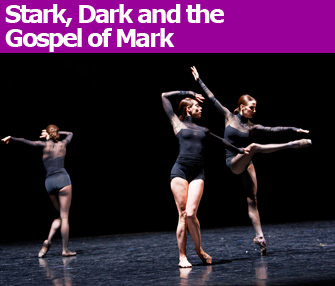 |
| The movements were unrelated to the Baroque music in Emanuel Gat’s “Hark!” Photo:Agathe Poupeney/Opéra National de Paris |
 |
| The movements were unrelated to the Baroque music in Emanuel Gat’s Hark! Photo:Agathe Poupeney/Opéra National de Paris |
Hark!, the headliner of a triple bill of modern-dance pieces at the Ballet de l’Opéra National de Paris might better have been called Stark!
This new piece (at the Palais Garnier through May 17) for 13 female dancers by Israeli choreographer Emanuel Gat is technically sound and offers up some interesting moments – particularly when all the dancers are working together – but the movement is devoid of emotion and seems totally unconnected to Gat’s choice of moody, melancholic song by British composer and lutenist John Dowland (1563-1626). The dancers, soberly dressed in black, perform in front of a gray, industrial-style wall with diagonal girders.
Tension is effectively created by a regular drumbeat – meant to represent a slow heartbeat or a death knell? – but this piece came across as more of an exercise than a showpiece and failed to draw me in; I got the impression that Gat has a secret he doesn’t want to let the audience in on.
The second piece, White Darkness, by Spanish-born choreographer Nacho Duato, is far more engaging. A depiction of the emotional downfall of an ordinary woman who is introduced to drugs by her lover, the piece features a series of graceful pas de deux by the lead couple. She is dressed in an elegant purple gown, while he wears steely gray slacks and shirt. They dance against a backdrop of an opulent black ruffle blind that contracts and expands to reflect the tension of the piece, while a snowfall of white powder, presumably cocaine, intermittently showers down from above.
They are not alone onstage: their story is punctuated by the spirited and seemingly freestyle movement of a handful of scantily clad, hedonistic couples, whose drug-induced frenzies – danced to a thrilling soundtrack by Welsh composer Karl Jenkins – are a treat to watch.
The increasing dependence and desperation of the lead female is artfully displayed in movement. In the final moment she is just a shell, on her knees, falling forward as her lover walks away.
MC 14/22 “ceci est mon corps,” by Franco-Albanian choreographer Angelin Preljocaj, is a testosterone-fueled piece for 12 male dancers that sets out to explore masculinity and the male body though its representation in Christianity. As the title suggests, its thematic starting point is the account of the Last Supper in the gospel of Mark.
Most of the “chapters” include a meaty depiction of male aggression or torture, accompanied by thrashing drumbeats or anachronistic, artillery-like sounds, but we also see the subsequent suffering and washing of wounds, and scenes of men enjoying each other’s company. In one section, the dancers pose in tableaux – some of which evoke the paintings of Caravaggio – representing, for example, the Crucifixion or the Last Supper.
Six steel tables make great props, either stacked up as cages or set out lengthways, with the dancers moving around, over and under them. In a few excellent sections, the dancers paired off into six couples dancing in unison or alternately.
While I would happily sit through parts of MC 14/22 again, overall it was too long and disjointed, and not a little self-indulgent.
Opéra National de Paris, Palais Garnier: 8, rue Scribe, 75009 Paris. Métro: Opéra. Tel.: 0 892 89 90 90 (33 1 72 29 35 35 from abroad). Tickets: up to €67. Through May 17. www.operadeparis.fr
Click here to respond to this article (your response may be published on this page and is subject to editing).
© 2009 Paris Update
Favorite